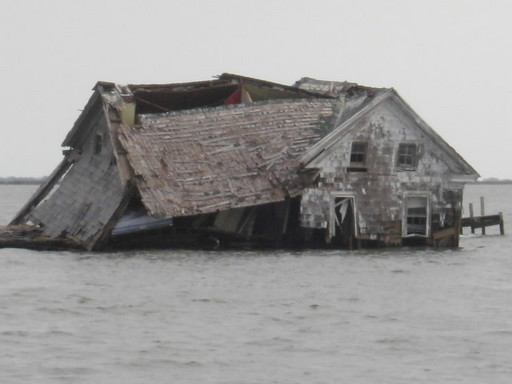Rising sea level claims last house on disappearing island in Chesapeake Bay
By Tim Wheeler
October 20, 2010 The last house standing on Holland Island, an eroding sliver of land in the middle of the Chesapeake Bay, has been claimed by the water. The two-story frame structure, abandoned and badly damaged by Tropical Storm Isabel in 2003, has been teetering on the brink of collapse for some time. High winds over the weekend apparently did it in. The picture here was taken by Shawn Ridgley, an educator at the Chesapeake Bay Foundation’s Karen Noonan Center in southern Dorchester County. Tip of the Sun visor to former colleague Tom Pelton, now with the Bay Foundation, who first reported this on the foundation’s Bay Daily blog. Once occupied by 2-300 people and more than 60 homes, the island had been eaten away so badly by storms and the bay’s rising sea level that it was abandoned in the early 20th century. It was used as a hunting preserve and a campsite by countless kayakers and boaters in ensuing decades. An Eastern Shore minister and former waterman bought the island in the 1990s, and set up a foundation intent on preserving it – but ultimately couldn’t muster enough resources or help. For more on this vanishing slice of bay geography and history, go here and here.
Bay claims last house on disappearing island
By David A. Fahrenthold
Washington Post Staff Writer
Monday, October 25, 2010 ON HOLLAND ISLAND, MD. The story was strange enough to be a child’s fable: In an isolated section of the Chesapeake Bay, there was a two-story Victorian house that seemed to emerge directly from the water. And, scurrying around it, there was a retiree, trying to keep the house from falling in. Finally, the man gave up. And last week, the house did, too. Raked by a storm, it cracked at the spine and collapsed into a one-story wreck. The tale of the house and the man illustrates the Chesapeake’s problem with rising oceans and sinking land. It has already erased life on most of the bay’s islands and now is threatening to erase the islands themselves. The century-old house was the last structure left on Holland Island, an abandoned watermen’s community. Waves had eroded so much land that, at high tide, the house seemed to sit directly on the waves. … Sea levels in the Chesapeake, scientists say, are rising faster than they are in some other coastal regions of the United States. The Earth’s oceans are rising, scientists say, because polar ice is melting, and because warmer water expands. They have noticed the effect of climate change more in the past couple of decades, government scientists say. … It definitely won’t, however, be the end of the Chesapeake’s erosion problems. A few miles away, a watermen’s community on Smith Island is just a few inches above the waves. And Maryland is contemplating how to, in one official’s words, “facilitate abandonment and retreat” when faster-rising waters eventually threaten towns on the Eastern Shore’s mainland. …
